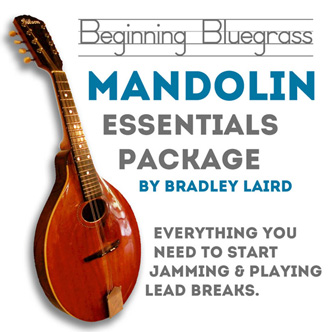|
HOME | FREE MANDOLIN CHORD CHARTS | FREE VIDEO LESSONS | FREE PODCAST FOR STUDENTS FREE BEGINNING MANDOLIN LESSONS | FREE MANDOLIN TABS | BRAD'S eBOOKS |
||||
Supercharge
your mandolin playing at Brad's MandoUniversity 
©2020 Bradley Laird |
FREE
MANDOLIN LESSON 12 - by Bradley Laird
HOW
TO SPEND AN HOUR PLAYING 16 NOTES Play this simple 16 note exercise once and then read what follows:
Here is a big secret to playing well. When practicing you must do a detailed and concentrated analysis of every finger and pick movement. Let me go over some of the finer points you should be thinking about as your practice each note: YOU SHOULD, WHILE PRACTICING, THINK ABOUT ALL OF THIS BETWEEN EVERY NOTE and... YOU SHOULD, WHEN PLAYING OR PERFORMING, THINK ABOUT NONE OF THIS!!! That is what makes practicing different from playing. HERE IS THE "ALL OF THIS" I REFERRED TO: Pick - Grip the pick fairly lightly. Do not lock the pick in an iron death grip. Play with the very tip of the pick and keep only about 1/4" of pick "showing" between your fingers. Play with a slight forward tilt to the pick so the edge of the pick contacts and slides over the string rather than dragging the flat side over. The front edge does the picking on the down stroke and the back edge on the upstrokes. It is a very slight tilt; perhaps one pick thickness. Are you placing the pick too "deep in the strings?" About an 1/8" is plenty. Even less is better. Just use the very tip of the pick. Just enough so you don't miss the top of the strings. Are you seeing both strings vibrate when you play them? Are you allowing the pick to "push through" both strings?
Play the exercise at the top one more time--v e r y s l o w l y ! OK, now get out your watch with a second hand. Play one note every four seconds. That's how slow I am talking about. Those sixteen notes will take 64 seconds to play through just one time. Why do all of this? Wouldn't it make sense to practice playing fast if I want to become a faster player. Nope. Slow practice means faster playing. Here is how it works. When you run through the exercises at a moderate speed (say 1 note per second) and make some fingering errors, or allow some tension to build somewhere, then your muscles will presume this is what you want them to do and after a few poorly executed attempts THIS IS WHAT IT WILL LEARN. How to execute things poorly. Your muscles do not care, nor do they know what you want them to do. I want you to play so perfectly, everytime, so that your muscles only memorize one way of doing things... THE PERFECT WAY. Can you play the exercise perfectly at 1 note per 4 seconds? If not, why go faster until you can? Playing sloppily will teach your muscles that it is OK to make mistakes. Now,
don't be discouraged into thinking that if it takes a full minute
to practice 16 notes, and there are hundreds of songs I want to
learn to play, that you will never have enough time to do this. This
is a common misconception. You see, practicing these 16 notes, and
various tunes and exercises, to this "Nth degree" will
make all of your playing improve. This phase is not about learning
tunes. It is about learning technique. Get I have written a book, which is meant as a follow-up to "Mandolin Master Class" which is a complete set of exercises to help you get control of your fingers and learn the fingerboard and the sounds of the mandolin. If you think this might help your playing take a look at "Mandolin Training Camp".
This way -------> to Lesson 13.
| |||





